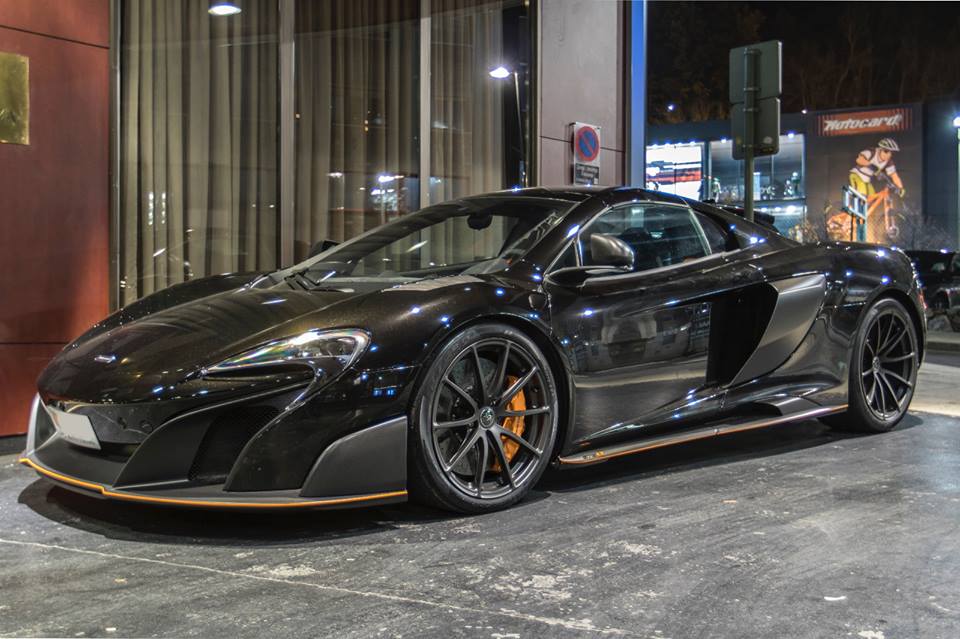Mclaren 675 LT: black Spider in Andorra la Vella
The McLaren 675LT is a lightweight, track-focused evolution of the McLaren 650S. It was announced in February 2015 and introduced at the 2015 Geneva Motor Show. McLaren only made 500 675LT Coupe (without counting the special editions such as the MSO HS).
As with the 650S, the 675LT makes use of single-piece carbon fibre monocell weighing 75 kg (165 lb), and carbon fibre use in the vehicle is increased in order to further minimise weight and increase rigidity. The 675LT is supplied with new carbon ceramic brake discs to increase braking performance over the 650S. Disc sizes are 394 mm at the front and 380 mm at the rear. Six-piston calipers grip the front discs with four-piston caliper used for the rears. Braking performance is also aided by the air brake ability of the new rear wing.
The 675LT makes use of a new 10-spoke wheel design, each weighing 800 g less than the alloy wheels on the McLaren P1, supplied in a 19-inch front and 20-inch rear fitment.
The new wheels are shod in Pirelli P-Zero Trofeo R track-focused, street-legal tyres which increase grip by up to 6% over the P-Zero Corsa sold with the 650S.
The length of the 675LT is 33 mm (1.3 in) more than the 650S. The 675LT utilises a new rear wing/air brake assembly 50% larger than that used in the 650S, along with a new carbon fibre diffuser and an 80% larger front splitter with sizeable endplates that together increase total downforce by 40%.
New carbon fibre pieces include both the front and rear bumpers as well as front undertray, rear fenders, side intakes and decklid that contribute to the significant weight savings over the 650S.
Alcantara is used throughout the interior where carpeting is removed and removal of the air conditioning unit and new carbon fibre race seats together save 26.5 kg (58 lb) although an adjustable passenger seat and air-conditioning are included as no-cost options. Other differences from the 650S’ interior include the integration of climate controls into the centre console mounted touch screen. 1 millimetre thinner window glass further reduces weight by 3 kg (7 lb). New 10-spoke forged aluminium wheels with titanium wheel nuts reduce weight by 1 kg (1.8 lb). This extreme focus in weight saving results in a dry weight of 1,230 kg (2,712 lb), 100 kg (220 lb) less than the 650S.
The car is powered by a variation of the M838T 3.8 L; 231.8 cu in (3,799 cc) twin-turbocharged V8 engine rated at 675 PS (496 kW; 666 hp) at 7,100 rpm and 700 N⋅m (516 lbf⋅ft) at 5,500 rpm. This is achieved through the addition of new lightweight connecting rods, a bespoke camshaft, an electronic recirculation valve and a lightweight titanium exhaust featuring dual circular outlets. Also used in the engine are revised turbocharger compressor wheels and an optimised fuel pump.
The 675LT uses the 7-speed automatic dual-clutch gearbox used in the 650S, with improved software reducing the shift time.
The 675LT can accelerate from 0–100 km/h (62 mph) in 2.9 seconds, 0.1 seconds faster than the 650S. 0–200 km/h (124 mph) in 7.9 seconds, 0–300 km/h (186 mph) in 25.9 seconds, 0–322 km/h (200 mph) in 31.2 seconds, and do the 1⁄4 mile (402 m) sprint in 10.3 seconds at 227.1 km/h (141.1 mph), continuing on to a claimed top speed of 330 km/h (205 mph).
The 675 in the 675LT model name refers to the power output of 675 PS (496 kW; 666 bhp), following the naming scheme started by the 650S.
The LT in the model name is a reference to the “Long Tail” 1997 McLaren F1 GT which was the final incarnation of the F1 road car built to comply with FIA homologation regulations for the 1997 F1 GTR.
The F1 GT featured extended front and rear overhangs that produced similar downforce to the previous homologation special, the F1 LM, without the use of a drag-inducing fixed rear wing.











